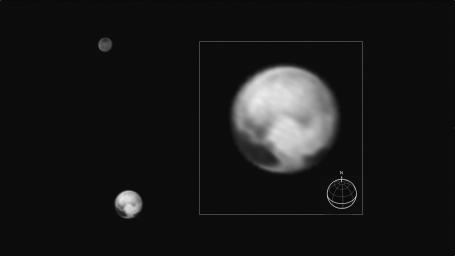This image of Pluto and its big moon Charon was taken by NASA's New Horizons spacecraft at 04:15 (UTC) on July 1, 2015, and shows the clearest view yet of the sides of Pluto and Charon that will be studied in great detail during New Horizons' closest approach to the dwarf planet on July 14, 2015. There will be just two more rotations of Pluto and Charon, and two more orbits about their mutual center of gravity, between the time of this image and closest approach (the rotation period of the system is 6.4 days). The image, which has been sharpened by the image processing technique known as deconvolution, shows details as small as about 160 kilometers (100 miles). The highest-resolution images of this side of Pluto, taken on July 14, will show details that are 1,000 times smaller.
New Horizons is revealing Pluto to be a world that, at this point, looks like no other in the solar system. Its equatorial regions are occupied by a discontinuous band of very dark material, which is interrupted on this hemisphere by a very bright region which appears sharp-edged at the resolution of the image. The north polar region is blander, but shows a distinctive darker southern boundary where it meets the higher-contrast equatorial regions. The origin of these remarkable features is still unknown, though some of them might be related to seasonal movement of frost across Pluto's surface. Charon, in contrast, still shows few details other than the dark polar region.
The image was taken by New Horizons' Long Range Reconnaissance Imager (LORRI ) at a distance from Pluto of 15.8 million kilometers (9.8 million miles) and has a central longitude of 177 degrees on Pluto and 357 degrees on Charon. The inset shows the orientation of Pluto- the solid lines mark the equator and the prime meridian, which is defined to be the longitude that always faces Charon.
The Johns Hopkins University Applied Physics Laboratory in Laurel, Maryland, designed, built, and operates the New Horizons spacecraft, and manages the mission for NASA's Science Mission Directorate. The Southwest Research Institute, based in San Antonio, leads the science team, payload operations and encounter science planning. New Horizons is part of the New Frontiers Program managed by NASA's Marshall Space Flight Center in Huntsville, Alabama.

 Planetary Data System
Planetary Data System












